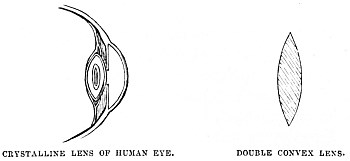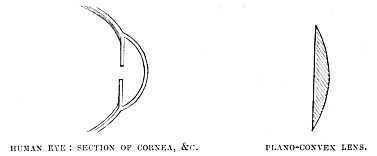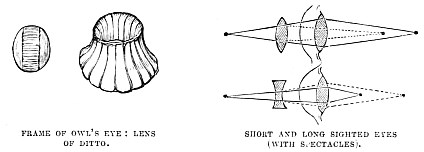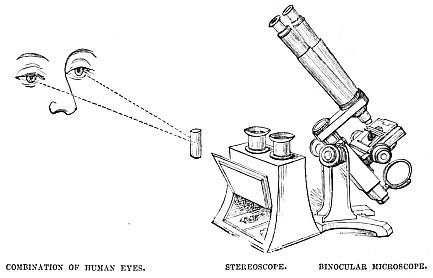 полная версия
полная версияNature's Teachings
Then we have various insect jaws, especially those of the carnivorous species, one of the most curious being the large insect which is shown in the illustration, upon a very reduced scale. In the male the jaws are exceedingly long and curved, as may be seen by reference to the illustration. I have now before me a pair of sculptor’s callipers, and the resemblance between them and the jaws of the Sialis is strangely close, the curve being almost exactly the same in both cases.
The scientific name of this insect is Sialis armata, and it is a native of Columbia.
OPTICS
CHAPTER I.
THE MISSIONS OF HISTORY.—THE CAMERA OBSCURA.—LONG AND SHORT SIGHT.—STEREOSCOPE AND PSEUDOSCOPE.—MULTIPLYING-GLASSES
The Camera Obscura.—Telescopes, Microscopes, and Spectroscopes, and their separate Objects.—Structure of the Camera Obscura.—The Double Convex Lens.—Its Use as a Burning-glass.—The Meridian Gun in Paris.—Signification of the Word “Focus.”—The Human Eye and its Analogies to the Camera Obscura.—Forms of various Lenses.—Long and Short Sight.—Their Causes and Means of Remedy.—Alteration of Sight in the Diver.—Long and Short sighted Spectacles.—The Eye of Birds.—Its beautiful Structure.—Washing-glasses and the “Nictitating” Membrane.—Combination of Images.—Natural Stereoscopes.—The Pseudoscope and its Effects on an Object.—The Multiplying-glass.—The Eight Eyes of the Spider and their Arrangement.—The Seventy Thousand Eyes of the Butterfly.—Form of the Facets.
HISTORY seems to fall into natural divisions, and to write the records of time in successive epochs, recording the advance of the human race. Some of them have apparently disappeared except by the strange relics which they have left behind, but though nothing is known of the men who worked in these ancient times, they stamped their mark upon the earth, and evidently left the world better than they found it.
A very admirable treatise on this subject has been written by the late Rev. J. Smith, called the “Divine Drama of Creation.” In this work he divides the progress of the human race into five acts, like those of a drama. The first act is the Hebrew Mission, the second the Greek Mission, the third the Roman Mission and the Middle Ages, the fourth the National Mission, and the fifth the Universal Mission.
Certainly a scene of the last act is now in progress, and may be entitled the Scientific Mission. The last hundred years have been indeed the age of discovery, and, during that time, the life of civilised man has been quite altered, so that practically his sojourn upon earth has been doubled. Steam, with all its various applications, electricity, and other kindred arts have become so intermingled with our lives, that it is difficult to imagine what our state would be if we were suddenly and utterly deprived of them. The loss to all would be incalculable, and not the least of the losses would be that of ready communion with our fellow-creatures.
Of these arts we will now take that which is named at the head of this division of the book, and see how far it is a development of natural facts.
The Camera Obscura and the EyeI have already spoken of arts as being akin to each other. They are more than this, and every day of the world’s progress teaches us that Art, Science, and Manufacture are sisters, all born of one family, and all depending mutually on each other.
Take, for example, our present theme—namely, Optics—and see how dependent it is upon Manufacture and Art. Without the former, man could not construct those beautiful telescopes, microscopes, spectroscopes, of the present day, which are evidently but the precursors of instruments which will work still greater marvels.
The first enables us to see solar systems without number, to which our own, vast as it seems to us, is but as a grain of sand in the desert. The next instrument makes revelations as marvellous of the infinitely minute as does the telescope of the infinitely great, enabling us to see living organizations so small that thirty-two millions could swim in a cubic inch of water. The third, a comparatively modern instrument, reveals the composition of objects, and can detect and register the materials of which the sun and fixed stars are made, or detect an adulteration in wine. It can adapt itself equally to the telescope and microscope, and the very same instrument which will reveal the character of an invisible gas in the Pole-star, when attached to the telescope, can, when connected with the microscope, point out the presence of half a corpuscle of blood where no other instrument could discover any trace of it.
All these instruments, together with many others, will be described in the present division of the work, and their analogies with Nature shown.
We will now take the subject of the Camera Obscura, an instrument with which the photographic apparatus of the present day has made most of us familiar. As its action depends chiefly upon the glass, or lens, through which the rays of light pass into the instrument, we will first explain that.
A “lens” is a glass formed in such a manner that the rays of light which pass through it either converge to a focus, or are dispersed, by means of the law of refraction. Every one who has been photographed—and who has not?—will remember that when the sitter has taken his position, the photographer brings to bear upon him a circular glass fixed into a short tube, and then looks through the instrument as if he were taking aim with some species of firearm. It is no matter of wonder that when savages see the photographic camera for the first time they are horribly frightened, for there is really something weird-like in the appearance of the lens thus presented.
Now, this lens is of the shape called “double convex,” both sides being equally rounded, so that a section of it would be shaped very much like a parenthesis (). The effect of this form of lens is to bring the rays of light to a point at a given distance from the centre. This point is called the “focus,” and is well known by means of the common burning-glass, which will set fire to objects placed in its focus, while itself remains quite cool.
I have seen lead pour down like water when placed in the focus of a large burning-glass, and even the harder metals will yield to the power of the sun’s rays when thus concentrated.
There is nothing which gives a more vivid idea of the amount of heat thrown on the earth by the rays of the sun than the effects of a moderately large burning-glass—say one of six inches in diameter. If we trace a circle of this size on the surface of the earth, it does not seem as if any very great amount of heat can be received, but when we catch the rays of that circle in our glass, and bring them together upon the focus, the amount of heat can be appreciated. The well-known meridian gun in the Palais Royal is fired by the sun. A burning-glass of no very great size is placed over the touch-hole of the gun, with which its focus coincides. The lens is turned in such a manner that, as the sun attains the meridian, its rays are thrown upon the touch-hole, and consequently fire the gun.
The word focus is the Latin term for a domestic hearth, and is used in allusion to the heat which is manifested at the point on which the rays of the sun converge.
It is evident that, after reaching the focus, the rays, if they be not intercepted by some object, will cross each other, and form a large image, but reversed. This part of the subject will presently be explained.
The accompanying illustration shows two figures, one representing the section of a double convex lens made by the hands of man, and the other that of a double convex lens as seen in Nature.

The former has already been explained. The latter is the double convex lens of the human eye, by means of which the images of external objects are conveyed to the brain. Whenever this lens becomes thickened by disease, the sight is gradually dimmed, and at last total blindness is the result. This disease is popularly called “cataract,” and until late days was incurable. Now, however, any good oculist will attack a cataract, and either partially or entirely restore the sight. This operation is performed by carefully removing the convex lens, and supplying its place with a glass lens, which throws the rays of light on the same focus.
The figure shows the double convex lens of the human eye in its place.
Having now seen something of the properties of the double convex lens, we will examine its application to the Camera Obscura.
The lens is placed on one side of the camera, and is so made that it can be slid backwards and forwards, and the focus altered at will. The camera itself is a box completely closed, so that no light can enter it except that which passes through the lens. The latter is so arranged that the rays which pass through it are crossed, and throw their image on the opposite side of the camera. In the photographic camera a piece of ground glass is placed at the end, so that the rays fall upon it, and the operator can see whether the image is a good one. Of course the figures are reversed, so that the sitter seems to be on his head, but that is a matter of no consequence. Exactly the same effect is produced by the marine telescope.

The general structure of the camera is shown in the illustration, all needless details being omitted.
I may here remark that the term “camera obscura,” or dark chamber, alludes to the fact that the box is completely closed, and, but for the rays which pass through the lens, would be absolutely dark.
The opposite illustration shows the most perfect camera obscura that can be imagined, namely, the human eye. Here we have a dark chamber, a double convex lens, and an image falling upon the back. Here the optic nerve comes into play, takes cognisance of the image, and conveys the idea to the brain. With a little trouble, a real eye, say that of an ox, can be dissected out, and employed as a camera obscura, the operator seeing in the back of the eye, or “retina,” the same image which the ox would have seen if it had been alive.
In photography, the operator, when he has found that a perfect image is thrown upon the ground glass, which represents the retina of the eye, substitutes for it a sensitive surface, on which the rays are projected, and which, by chemical means, produce a permanent instead of a fleeting object.
Examples of other lenses may be found in Nature. She, moreover, can perform a task which man has never even attempted, namely, the change of form in a lens according to the duty which it has to do. How this wonderful object is attained we shall presently see.
There is a form of lens extremely useful in Optics, namely, the “Plano-convex” lens. This is, in fact, one half of a double convex lens, the section being made through its edges, and the plane sides polished as well as the convex. As, however, this is only a half of the double convex lens, it does not need further explanation. Its natural counterpart may be seen in the annexed illustration.

A somewhat more complicated form of lens is called the “Meniscus,” one side of which is convex and the other concave. A good example of the meniscus may be found in the old-fashioned watch-glass, before watchmakers took to flattening them, and watch-wearers were not ashamed to carry a “turnip,” in which there was room to spare for the works. If a section of such a glass were taken, it would assume the form of a half-moon. This, in fact, is the meaning of the term “meniscus,” which is a Greek word, signifying a little moon. If the same glass were solid, or even filled with water, it would form a “plano-convex” lens.
Of course the outer curve of the meniscus must be larger than the inner curve, but in some cases the disproportion is very strongly marked, the outer curve being very large, and the inner curve very small. An example of such a meniscus may be seen in the human eye. If the reader will refer to the illustration on page 280, in which the structure of the eye is shown, he will see the meniscus lens in combination with the double convex. The former has already been explained, and the latter is formed by the vitreous humour which fills nearly the entire globe of the eye. Its larger curve is due to the form of the eyeball, and the smaller to the convex lens.
Long and Short SightIt has already been mentioned that the focus of a convex lens is shorter in proportion to its convexity, and that in consequence its magnifying power is increased. For example, the large glasses through which pictures are viewed are comparatively thin in proportion to their diameter, while the lenses employed for the highest powers of the microscope are scarcely larger than small shot, and nearly as globular. It naturally follows that any instrument to which a lens is adapted, whether it be microscope or telescope, must depend for its focus on the greater or less convexity of the lens in question.

Again taking as our example the human eye, we find that there are very few persons who from youth to age possess or preserve eyes which can read small type at a moderate distance, and can clearly define the outlines of distant objects. Nearly all people, even if in their youth they possess good sight, lose it as they grow older. They can discern distant objects well enough, but, when they come to reading, they are obliged to hold the book at arm’s length before they can distinguish the letters.
This defect is caused by the insufficient convexity of the lens, so that the focus is thrown too far back, and it is corrected by wearing spectacles sufficiently convex to supply the deficiency in the lens of the eye.
An admirable example of temporary long-sightedness is familiar to every diver, though he may be unconscious of its cause. Suppose that into very clear water of some twelve feet in depth, a white object, say a common jam-pot, is thrown, it can be clearly discerned from the shore, unaltered in shape or size. But, when the diver searches for it, he sees at first only something white, large, undefined, and wavering, and only finds it resume its proportions as he approaches it. This phenomenon is due to the pressure of the water upon the eyeball, which flattens it, and so throws the focus too far back for a clear image. Nowadays this defect is remedied by the use of very convex spectacles, so convex, indeed, that, if worn in the air, they would render the wearer incapable of seeing anything at more than an inch or so away from him. But, when worn in the water, they only supply the deficiency of the compressed eyeball, and so restore the focus to its proper position.
Those who suffer from short-sightedness can see with great distinctness objects which are close at hand, but those at a little distance seem to have no particular outline, and appear as if they were viewed through a fog, thus causing a constant and almost painful strain on the eyes. The cause of this defect is the too great convexity of the lens, which therefore throws its focus short of the required spot. The means of remedy are exactly opposite to those which are used for long-sighted persons, a concave lens being placed in front of the eye, so as to throw the focus farther back, and relieve the organ from the strain.
Although we have not yet invented a machine that can alter the focus at will, we may take a hint from Nature. We have already seen how the pressure of water upon the front of the eye lessens its convexity, and makes it long-sighted. Consequently, if we could apply pressure round it, we could make it more convex, and so neutralise the weight of the water.
There is a wonderful piece of machinery in Nature which really does perform this office, the eye, at the will of its owner, becoming either telescopic or microscopic. This quality is very desirable in birds, especially those which are predacious and of rapid flight, as they might either fail to see their prey at a distance, or might dash themselves against some obstacle when they were close upon it.
The eye of the Owl affords a beautiful example of machinery which produces this effect, and the means which are used may be understood by inspecting the accompanying illustration.
It will be seen that the eyeball is set in a framework composed of thin bony plates, just like a glass in a telescope. When these plates are relaxed, the whole eyeball is flattened, so as to enable the bird to see an object at a very great distance. But, when they are contracted, they render the whole eye globular in proportion to their pressure, and enable the bird to see objects which are very close to it. In fact, the eye becomes a telescope or microscope as needed.
Many reptiles possess this arrangement of bones, but the birds have even a more delicate mode of obtaining the focus of the eye. This is by means of a curious organ called, from its shape, the “pecten,” or comb, which is placed in the vitreous humour at the back of the eye, and connected with the optic nerve. It is a congeries of arteries and veins, so that it can be rapidly enlarged by forcing blood into it, or diminished by allowing the blood to withdraw.
As the liquid in which it rests is practically incompressible, it follows that when the comb expands, it causes the chamber of the vitreous fluid to expand, and so forces the lens forward. When, however, the blood retires from the comb, the lens returns to its original place. This, as the reader may have noticed, is the same principle as that which is followed in altering the focus of a telescope in order to suit the sight of different individuals. Perhaps a still better illustration may be found in the coarse and fine adjustment of the microscope, the former of which moves the whole tube, and may be compared to the bony ring; while the latter causes one part to slide over the other, and is analogous to the comb.
The movements of this organ are believed to be as involuntary as the dilatation and contraction of the iris; but, whatever may be the case, it is one of the most beautiful examples of natural mechanics, and far surpasses the most delicate machine that can be made by man.
In the illustration of the microscope, which is to be found on page 286, both these movements are given, the double vertical wheel being the coarse movement, and the fine movement being supplied by the single vertical wheel just above them.
While we are on this subject, we may see how Art unintentionally copies Nature, even in trivial details. Every one who is in the habit of using optical instruments, more especially those who are forced to wear spectacles, are aware of the necessity of keeping the glasses as clean as possible, and, where the instruments are delicate, always have by them a piece of clean wash-leather for the express purpose of wiping the glasses.
Here, again, Nature has anticipated Art. In our own case, we have in the human eye a good example of such natural mechanism, the eyelids being formed quite as much for the purpose of washing the surface of the eyeball as of excluding light.
Many animals are provided with a special apparatus for the purpose, called the “nictitating membrane.” It is, in fact, a sort of inner or supplementary eyelid, which can be drawn over the eye while the external lids remain comparatively unmoved. It is very conspicuous in the owls, and gives to those birds that almost comical look of perpetual blinking with which we are so familiar.
The Stereoscope and PseudoscopeMany persons have wondered how it happens that, as we have two eyes, we do not see two images instead of one. Practically, this is always the case, for the eyes, especially when they look on solid bodies, see two different images, because they contemplate the object from different points of sight.
This may be easily ascertained by looking at a given object first with one eye, and then with the other, when it will be seen that the image presented to the right eye is slightly different from that of the left eye, but that the two can be combined into one by a very slight inward movement of both eyes, and thus the effect of a solid body be produced. Sometimes, when people are weak, and cannot control the united movement of the eyes, not only two, but five or six images are at once presented to the mind, and produce a strange sense of bewilderment and confusion.

Painters are obliged to avail themselves of this peculiarity, and to make allowances for the double vision. If they do not, the effect of the painting is flat, and it appears as if the artist had only used one eye.
A good proof of this fact may be seen in Stereoscopic photographs, especially of scenery. If each be viewed separately, it often appears quite unintelligible, but, when they are combined by the instrument, they seem to spring into life as it were, and appear solid enough to be grasped.
Now, the Stereoscope is avowedly constructed on the same principle as the double vision of the eye, so that when it applies itself to two photographs of the same object which have been taken from different points of view, it combines them, and gives them as solid an appearance as if they were realities.
So wonderfully close is the representation, that the idea of a place obtained by means of the combination of the photograph and Stereoscope is quite as vivid and correct as if it had been gained by actual observation.
The principle of the Stereoscope is now applied to the best microscopes, and its value is incalculable, especially when low powers are used, i.e. those of not less than half an inch focus. The real beauty of many objects could never have been appreciated but for this discovery, nor their true form defined.
On the left hand of the illustration is shown the combining power of the eyes. Supposing the right eye only to be brought to bear upon the little cylinder, only one side of it will be seen, and it looks nearly flat. The same is the case with the left eye. But, when both eyes are used together, both sides of the cylinder are presented to the mind, and thus we get the effect of solidity.
The Stereoscope is so formed, by means of lenses, that the two figures become combined into one, the rays of light being turned out of their course by the arrangement of the glasses.
The Stereoscope, however, although a useful assistant to the vision, is not necessary. It is perfectly possible to combine the two figures without any stereoscope, and to do so merely by squinting, if we may so call it, at the figures. The power of combination is gained with a very little practice, and in a short time the observer will be capable of producing stereoscopic effects without needing a Stereoscope. This ability is very useful when inspecting photographs in a shop-window. Of course the figures are not so much enlarged as they are with the stereoscope, but they are nevertheless quite as clear and well defined.
There is an instrument called the Pseudoscope, which, as its name imports, gives a false idea as to the nature of the object which is viewed through it, converting hollow objects into solid, and vice versâ. The following description of its effect is given by Wheatstone:—
“When an observer looks with the pseudoscope at the interior of a cup or basin, he not unfrequently sees it at first in its real form; but by prolonging his gaze he will perceive the conversion within a few minutes; and it is curious that, while this seems to take place quite suddenly with some individuals, as if the basin were flexible, and were suddenly turned inside out, it occurs more gradually with others, the concavity slowly giving way to flatness, and the flatness progressively rising into convexity.
“Not unfrequently, after the conversion has taken place, the natural aspect of the object continues to intrude itself, sometimes suddenly, sometimes gradually, and for a longer or shorter interval, when the converse will again succeed it—as if the new visual impression could not at once counteract the previous results of recent experience. At last, however, the mind seems to accept the conversion without further hesitation; and after this process has once been completely gone through, the observer, on recurring to the same object, will not find it possible to see it in any other than its converted form, unless the interval should be long enough to have allowed him to forget its aspect.






